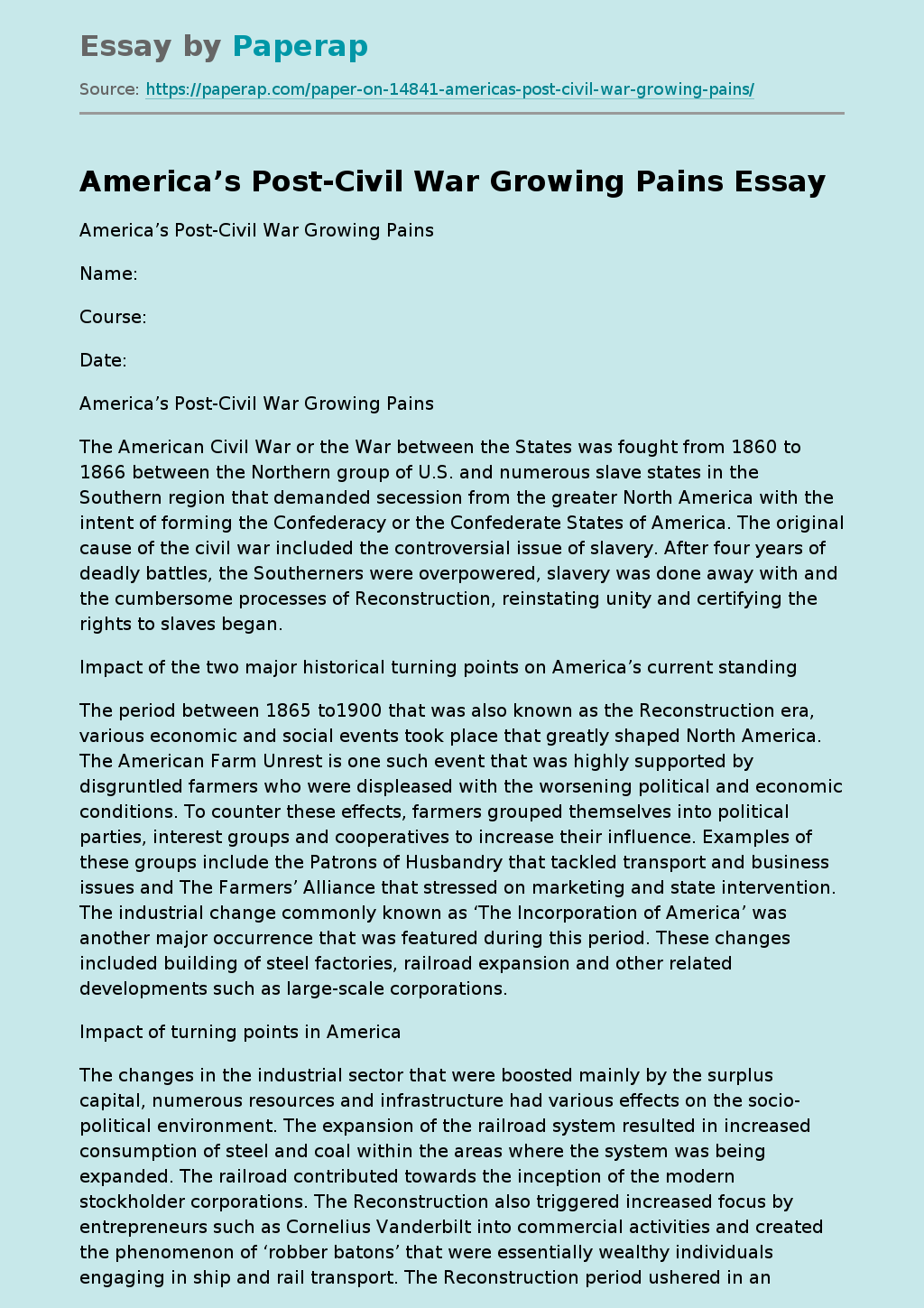The American Civil War or the War between the States was fought from 1860 to 1866 between the Northern group of U.S. and numerous slave states in the Southern region that demanded secession from the greater North America with the intent of forming the Confederacy or the Confederate States of America. The original cause of the civil war included the controversial issue of slavery. After four years of deadly battles, the Southerners were overpowered, slavery was done away with and the cumbersome processes of Reconstruction, reinstating unity and certifying the rights to slaves began.
Impact of the two major historical turning points on America’s current standing
The period between 1865 to1900 that was also known as the Reconstruction era, various economic and social events took place that greatly shaped North America. The American Farm Unrest is one such event that was highly supported by disgruntled farmers who were displeased with the worsening political and economic conditions. To counter these effects, farmers grouped themselves into political parties, interest groups and cooperatives to increase their influence.
Examples of these groups include the Patrons of Husbandry that tackled transport and business issues and The Farmers’ Alliance that stressed on marketing and state intervention. The industrial change commonly known as ‘The Incorporation of America’ was another major occurrence that was featured during this period. These changes included building of steel factories, railroad expansion and other related developments such as large-scale corporations.
Impact of turning points in America
The changes in the industrial sector that were boosted mainly by the surplus capital, numerous resources and infrastructure had various effects on the socio-political environment.
The expansion of the railroad system resulted in increased consumption of steel and coal within the areas where the system was being expanded. The railroad contributed towards the inception of the modern stockholder corporations. The Reconstruction also triggered increased focus by entrepreneurs such as Cornelius Vanderbilt into commercial activities and created the phenomenon of ‘robber batons’ that were essentially wealthy individuals engaging in ship and rail transport. The Reconstruction period ushered in an era of increased participation in politics especially among the black Americans residing in the South.
President Lincoln and the Reconstruction period
Abraham Lincoln was regarded by many as America’s best president. However, during the Reconstruction period, a large section of the population in the South viewed him as their ultimate adversary and tyrant. The main source of this hatred was the idea that President Lincoln was more focused on rebuilding the Union rather than reconstructing the South. Most of his proposals and policies were geared toward coercing the South into treaties with the Union for instance the 1863 Proclamation of Amnesty and Reconstruction for states provided they swore allegiance to the Union and the stand against slavery (Feldman, 2004). If President Lincoln had not been assassinated, the Reconstruction process would have been more wholesome and faster. His generous and fair approach toward the South meant that the President was prepared to work with all the citizens of the United States of America to ensure they maximized their Reconstruction efforts.
Effect of industrialization and urbanization during the Reconstruction period
The Reconstruction period was characterized by accumulation of personal wealth, poverty and development. The United States of America became progressively urban, and cities sprung up with higher population and size. Skyscrapers and expansive transportation systems became the hallmark of every city. There was an increased volume of immigration with people from various countries moving into the ‘Golden Land of America’ from as far as Mexico, China, Middle East and Russia.
On the political scene, focus shifted away from the mafia bosses such as George Cox and William Marcy Tweed and more toward institutionalized welfare system that improved the level of education, security and housing. Urbanization provided a ready market and an opportunity for research and development for technological products. Innovators such as Samuel Morse and Thomas Edison found a chance to develop products that improved communication in the world. People living in urban areas also developed a culture of increased consuming that saw the rise of supermarkets, convenience and department stores such as Macys, Woolworths and Sears & Roebuck (Kaplan & Valls, 2007).
Discriminatory laws against non-white citizens and immigrants
The various policy amendments during the Reconstruction period were known as Jim Crow laws. The laws were discriminatory against the black population within America. They prohibited black Americans from certain schools, public transportation, restaurants and public spaces. This discrimination was openly expressed by White Democrats who misappropriated their influence to isolate public spaces and amenities through the law and reinstate social control over African-Americans in the South (White, 2012).
The Jim Crow laws succeeded in imposing a strict racial segregation, relegating black people to substandard schools and other public amenities, forcing taxes and literacy tests with the intention of eliminating black people from either vying or voting, and achieving judicial support for discrimination. The Black Codes were another set of laws that also limited the civil rights and liberties of African-Americans. In areas such as Texas, these laws were embraced strictly and resulted in black people being reinstated the ‘slave’ label. The judicial system therefore played a major role in consenting to the amendment of most laws to include discriminatory articles that subjected the black community to economic and social hardships.
References
- Feldman G. (2004). The Disfranchisement Myth: Poor Whites and Suffrage Restriction in Alabama, Athens: University of Georgia Press
- Kaplan J. & Valls A. (2007). Housing Discrimination as a Basis for Black Reparations. Public Affairs Quarterly. Retrieved from http://people.oregonstate.edu/~kaplanj/Reparations.pdf
- White R. (2012). The Rise of Industrial America, 1877-1900. The Gilder Lehrman Institute of American History. Retrieved from http://www.gilderlehrman.org/history-by-era/essays/rise-industrial-america-1877-1900.
America’s Post-Civil War Growing Pains. (2018, Jun 28). Retrieved from https://paperap.com/paper-on-14841-americas-post-civil-war-growing-pains/

